Moniek Bloks's Blog, page 206
September 26, 2019
Elizabeth of Rhuddlan – The King’s favourite sister
Elizabeth of Rhuddlan was born on 7 August 1282 as the daughter of King Edward I of England and Eleanor of Castile. During her early years, Elizabeth was in the company of her mother, and she was with her mother when her brother, the future King Edward II, was born. They became very close. She was just two years old when a marriage was arranged for her. Her future husband was to be John, the son of the Count of Holland in a dual alliance with the Count of Holland’s daughter Margaret and Elizabeth’s elder brother Alphonso but that marriage never took place due to Alphonso’s early death. It was agreed that John would be sent to England to receive his education.
When Floris V, Count of Holland, was murdered on 27 June 1296, John was at the English court. Two days after his father’s murder, the nobles wrote to the English King to ask him to send the then 12-year-old John back to Holland. He did not respond until September and invited the nobles to come to England to arrange John’s marriage and his departure.
The marriage between Elizabeth and John took place at Ipswich on 7 January 1297. A long list of plate and jewels were provided for Elizabeth. For her chapel, hall and kitchen, a magnificent set of gold and silver plate was prepared, all the cups, dishes, bowls, pitchers, chandeliers, chalices, patens and alms-dishes. She had several jewelled headdresses. Her bridal robe was embroidered with silk and adorned with silver gilt buttons, and it took 35 tailors four days and nights to make it. Her coronet was gold, set with rubies, emeralds and pearls.
It was initially decided that the couple would return to Holland together, but Elizabeth’s father delayed her departure at the last moment, possibly because Elizabeth did not wish to go. Her father was so angry, he reportedly threw her coronet in the fire and although it was saved – two stones were missing. And so, at the end of January, John left alone from Harwich to head home. At the end of August, King Edward was in Flanders, and he had taken Elizabeth with him. He sent word to John to come pick up Elizabeth in Flanders, but John refused to set foot in Flanders – as they had harboured his father’s murderers. The couple was probably reunited in November of that year – almost a year after their marriage. Elizabeth spent her time in Holland at her palace in The Hague – which no longer survives. She took no part in public affairs and lived in quiet retirement. That is until August 1299 when her husband was in trouble. Elizabeth reportedly travelled to the marketplace, where she urged the people to fight for her husband. She was apparently in tears and managed to convince the people. The main troublemaker was eventually lynched.
On 27 October 1299, John and Elizabeth officially transferred the control of the county to John II of Avesnes, who was a grandson of Floris IV, Count of Holland, because of their youth. John was 15 at the time and should have been considered old enough to rule on his own, but it is likely that he was developmentally delayed, both mentally and physically. Elizabeth and John welcomed John II of Avesnes together, and the regency was supposed to last for four years. On 10 November 1299, John died in Haarlem, where he had gone hunting, of dysentery. He was succeeded by John II of Avesnes as Count of Holland. Later skeletal research showed that John was indeed physically underdeveloped.
Elizabeth now needed to secure her dower, and she had to appeal to her father to interfere in the matter. He promptly sent two ladies to Holland to comfort her in her grief. When her issue remained unresolved several months later, Elizabeth decided to leave Holland and return home. On her way home, she passed through Brabant where her sister Margaret lived. She reached London in August 1300. Her father and stepmother were in the north, and so Elizabeth travelled on. On 20 August, she met her stepmother – Margaret of France – for the first time, and they travelled together to meet the King at Rose Castle. On the first anniversary of her husband’s death, Elizabeth had massed said for his soul at the Church of the Friars Preachers at Carlisle and both she and her stepmother were present.
A few days later, Elizabeth joined her stepmother at Northampton all while continuing her negotiations about her dower lands. It would never be fully resolved, and Elizabeth now had to rely on her father. He soon decided it was time for a second marriage and this time Elizabeth would remain in England. On 14 November 1302, Elizabeth married Humphrey de Bohun, 4th Earl of Hereford, at Westminster. Elizabeth wore a crown of gold with rubies and emeralds – which had belonged to her stepmother’s sister Blanche – with a smaller circlet with 82 pearls, 12 rubies, 12 emeralds and 24 images wrought in gold. After travelling to Scotland with her new husband, her father and stepmother, Elizabeth found out she was pregnant and retired to Tynemouth with her stepmother. She called for a relic from Westminster Abbey, and two monks carried it to Tynemouth and remained there until Elizabeth gave birth to her first child – a daughter named Margaret – in September.
Elizabeth wished to join her husband in the north and sent baby Margaret to Windsor in a litter. Margaret lived there in the nursery with her infant uncles Thomas and Edmund. The following summer, Elizabeth found herself pregnant once more and retired to Knaresborough to await her confinement. She gave birth to a second daughter – who was named Eleanor – in early October. As soon as she recovered, she joined her husband in the north – taking Eleanor with her. Young Margaret died in early 1304. Elizabeth gave birth to her first son named Humphrey in 1306 – he would die young. A second son named John followed in 1307. A third son was called Humphrey as well, followed by twin son named Edward and William. They were followed by a daughter who was also named Margaret and a son named Eneas. They were frequent visitors to the English court.
Elizabeth’s father died in 1307, and her brother became King Edward II. Elizabeth was in constant correspondence with her brother and was one of the noble ladies who met his bride Isabella of France in Dover in 1308. He even continued to press for her dower lands in Holland.
On 5 May 1316, Elizabeth gave birth to her tenth child at Quendon. The child was born alive and given the name Isabella. Both Elizabeth and Isabella only lived for a few more days after the birth and died almost at the same time. Elizabeth was interred at the Abbey of Walden with her infant daughter nearby. Elizabeth was still only 33 years old.1
The post Elizabeth of Rhuddlan – The King’s favourite sister appeared first on History of Royal Women.
September 25, 2019
Mathilde Ludovika in Bavaria – The Queen’s Companion
In April 1843, Princess Ludovika of Bavaria – wife of Maximilian Joseph, Duke in Bavaria – wrote to her niece Mathilde (Princess Mathilde Caroline of Bavaria, later Grand Duchess of Hesse and by Rhine) that she was pregnant for the 7th time. She was “a little more miserable than usual, but when God gives me a healthy child, these complaints will disappear!” When the little girl was born on 30 September 1843 at Possenhofen, she was named Mathilde Ludovika and Princess Mathilde was asked to be a godparent. She quickly gained the nickname of “Der Spatz” – the Sparrow – probably due to her delicate constitution. Her father was present at her birth, though this was rather an exception than a rule.
Her mother spent a lot of time without her husband – very much unlike the happy family life portrayed in the famous Sisi movies. The siblings became very close, and Mathilde Ludovika was especially close to Marie Sophie. The family’s time was divided at Munich and Possenhofen – where life was quite informal.
When her elder sister Elisabeth married their first cousin Emperor Franz Joseph I of Austria, a painting was created with all the siblings, especially for her. It shows Mathilde Ludovika and her elder sister Marie Sophie with their favourite pets – a parrot and a dove. The family accompanied Elisabeth to Vienna.
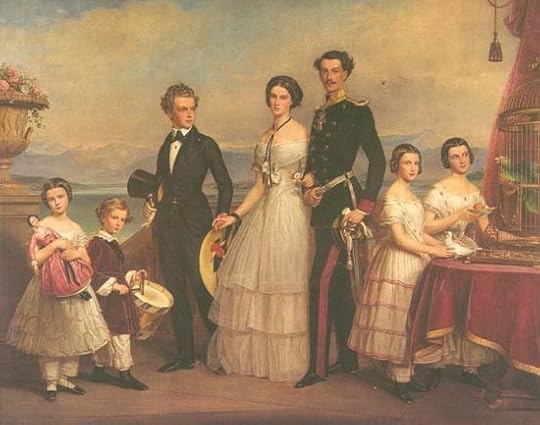 (public domain)
(public domain)When Elisabeth and Franz Joseph’s eldest daughter died in infancy in 1857, Mathilde Ludovika, Helene and Marie Sophie accompanied their mother to Vienna less than a week after the little Sophie died. Elisabeth was cheered by the company of her family but took the loss hard. On 8 January 1859, Marie Sophie married the future King Francis II of the Two Sicilies by proxy in Munich. Just five days, she said goodbye to her family, but both families may have already had a second match in mind. On 22 May 1859, Marie Sophie’s husband succeeded as King of the Two Sicilies. Marie Sophie was now Queen at the age of 17, but soon the Kingdom would fall, leaving them without a throne.
The loss of the Kingdom initially crushed plans to have Mathilde Ludovika married to King Francis’ half-brother Louis. However, the marriage of her elder sister had thus far remained without children – probably due to Francis’s phimosis – and an heir was needed. Prince Louis travelled to Bavaria to meet his future in-laws, and Mathilde Ludovika’s mother was charmed. “He is a dear, simple, comfortable person, he is modest and yet not timid, cheerful, and then, in conversation, very serious and sensible.”
On 6 June 1861, Mathilde Ludovika and Prince Louis, Count of Trani, were married at the Ducal Palace in Munich. Mathilde Ludovika and Louis joined their exiled family in Rome, but soon Prince Louis was more interested in other women. Marie Sophie and Mathilde Ludovika had each other at least. It was perhaps no surprise that the vivacious Marie Sophie – with her impotent husband – fell in love with Armand de Lavayss, a Belgian Captain of the Papa Guard. In August 1862, Marie Sophie left first for the baths of Soden and then to Taxis where her sister Helene lived. Newspapers reported that she was ill, but she was, in fact, expecting a child. On 24 December 1862, Marie Sophie gave birth to a daughter who was named Maria Cristina Pia. Not much is know about the girl, except that she was removed from her mother and either given to her father or adopted. She died at the age of 19 from consumption. Marie Sophie was devasted to be separated from her child, and she became very depressed. Her mother later commented, “I would have wished them husbands who had more character and knew how to give them guidance, of which both are still in great need; but good as the two brothers are, they are no support to their wives.” Duke Max shrugged it all off, saying, “Well, all right, such things happen. What’s the point of cackling?”
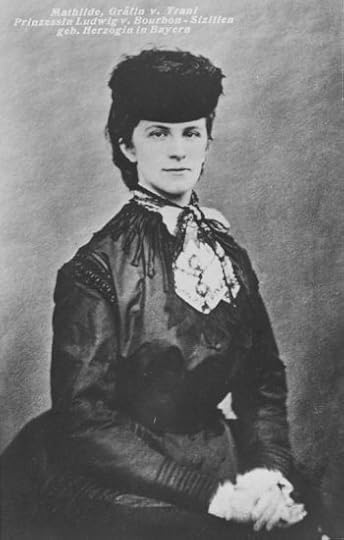 (public domain)
(public domain)Mathilde Ludovika followed her sister’s example and fell pregnant by the Duke of Ripalda. In early 1864, she gave birth to a daughter named Marie, who was adopted by her paternal family. Mathilde Ludovika too managed to make things right with her husband, at least long enough to have his child as well. On 1 January 1867, she gave birth to a daughter named Maria Theresa. Empress Elisabeth was with her sister for her confinement. Mathilde Ludovika had a slow recovery and Maria Theresa was to be their only child. The following year, both Marie Sophie and Mathilde Ludovika were present by the bedside of their sister Empress Elisabeth when she gave birth to Archduchess Marie Valerie. They both stood as godmothers for the newest addition to the family.
Mathilde Ludovika was soon on the move – without her husband but with their daughter, Maria Theresa – travelling to Munich, Paris and Baden-Baden. Prince Louis was known to be an alcoholic and reportedly also had an illegitimate child. Maria Theresa was known to be very anaemic, and her diet reportedly included chewing half-raw steak and spitting out the remains. Her hands and pinafore were soon soaked in blood to the horror of onlookers.
In 1886, Prince Louis died – officially due to heart disease – but he most likely committed suicide. The following year – still in mourning for her husband – Mathilde Ludovika and most of her siblings were together in Hungary to celebrate Empress Elisabeth’s 50th birthday. On 27 June 1889, Mathilde Ludovika’s only child Maria Theresa married Wilhelm, Prince of Hohenzollern and they had a daughter and two sons together. Maria Theresa’s health remained delicate, and she lived mostly in Bad Tölz and Cannes. She was in Cannes when she died at the age of 42 – most likely of multiple sclerosis.
In 1914, both Marie Sophie and Mathilde Ludovika moved back to Munich at the outbreak of the First World War to be close to their only other surviving sibling Ludwig Wilhelm. Both sisters had spells of depression in old age, and they were most likely quite lonely as well. Ludwig Wilhelm died of a stroke in November 1920, and now the sisters were the last ones standing. Marie Sophie was the first one to go, and she died of pneumonia on 19 January 1925 – leaving her estate to Mathilde Ludovika. She would outlive her sister for just five months – dying on 18 June 1925.1
The post Mathilde Ludovika in Bavaria – The Queen’s Companion appeared first on History of Royal Women.
September 24, 2019
Queen Sirikit of Thailand – The creation of an image (Part two)
To ease the panic about the succession, a marriage was arranged for Prince Vajiralongkorn. The chosen bride was his first cousin, SoamsawaliKitiyakara. However, Prince Vajiralongkorn didn’t like her, and he considered her plain and dull. Nevertheless, they married on 3 January 1977 and began touring the country. Soamsawali gave birth to a daughter named Bajrakitiyabha, but by then, he had moved out of their shared home. He was introduced to an actress named Sucharinee Vivatcharavong who became his girlfriend. She gave birth to a son named Chudhavajra who received the princely but noncelestial title of Mom Chao. For Sirikit, this threatened her own dynastic ambitions, unless her niece Soamsawali gave birth to a celestial prince. A second son for Sucharinee named Vajaresra followed in 1981. Soamsawali became depressed. When Sirikit visited the United States to see her Ubol Ratana’s first child with Peter Jensen, she told the press, “My son the crown prince is a little bit of Don Juan. He is a good student, a good boy, but women find him interesting, and he finds women even more interesting. If the people of Thailand do not approve of the behaviour of my son, then he would either have to change his behaviour or resign from the royal family.” It was a risky move for Sirikit, and Thai newspapers were warned not to print the comments. Sucharinee gave birth to a third son in 1983, followed by a fourth son in 1985.
Embed from Getty Images
Sirikit had been a celebrated Queen for the first 20 years, but she began to fight the ageing process. She began taking diet and energy pills, and she said, “My husband says he hates me to be fat.” When she became smitten by a Colonel Narongdej, people presumed they had an intimate relationship, and it became a scandal. When he died in 1985, her mourning for him was ridiculed. Her image suffered further damage when a rumoured account of a trip to the United States detailed how she had plastic surgery, collected money supposedly for her charities and how she stashed money just in case the monarchy went belly up. Sirikit wanted to be known as the incarnation of the legendary Queen Suriyothai who died in battle to save her husband. Her husband was only too willing to go along with this interpretation, and a massive statue of the legendary Queen was erected in Sirikit’s own park.
Soon Ubol Ratana wanted back into the family, and she prostrated herself at her father’s feet while pregnant with her first child. However, she and her husband returned home to the United States after just four days – she was not forgiven after all. She remained popular with the people, and the people demanded that her title was restored, but Bhumibol refused to do it. Her family eventually counted three children, and despite their problems, they visited Thailand often. Sirikit’s youngest daughter Chulabhorn married Virayuth Tishyasarin with her father’s permission, and she kept her royal title, and their two daughters were given titles.
Sirikit remained preoccupied with her rogue son and at the end of 1985 – after Sucharinee gave birth to a fourth son – she suffered a breakdown and disappeared from the public view for six months. Princess Chulabhorn came to her mother’s defence, “If the people are going to get angry because of her disappearance from the public view, it is us (her children) who should be blamed since we always insist that she rests instead of making appearances… Normally everybody has holidays, but her majesty never had one.” Sucharinee gave birth to a daughter in 1987 named Busyanampetch, and now Vajiralongkorn wanted official recognition for his girlfriend. But for that, he would have to divorce Soamsawali. In 1991, her title was reduced from royal consort to “mother of the King’s grandchild.” In the meantime, he was given more royal duties as was his only unmarried sister Sirindhorn, who was considered the workhorse of the family. Chulabhorn was considered the family’s scientist, but when Bhumibol and Sirikit tried to get the King of Sweden to award her the Nobel Prize, they were surprised to learn he had no such power. Chulabhornm spoke out against the growing AIDS problem in Thailand, but then she refused to embrace an AIDS patient.
Embed from Getty Images
In 1992, Vajiralongkorn finally sued Soamsawali for a divorce, but she rejected an offer of several million dollars. After a court case where Soamsawali could say nothing against the prince due to the strict lèse-majesté laws, the divorce became final in 1993. Vajiralongkorn and Sucharinee married in 1994, but the marriage soon turned sour. Sucharinee took their children to England and threatened to kill them and herself if he didn’t get rid of his other woman. He eventually publically expelled her from the palace and held onto their daughter. The palace insisted that their marriage had never been official. It could have been a victory for Sirikit to see her niece back in her rightful place, but Vajiralongkorn refused to return to her. He would marry twice more, fathering another son who is now first in the line of succession.
Embed from Getty Images
In a further attempt for Sirikit to establish her legacy, she pushed for the production of an epic movie about the legendary Queen Suriyothai and even selected the leading actress herself. The film cost over 10 million dollars and was at the time the most expensive Thai film ever made.
Embed from Getty Images
For Sirikit, this last decade has been difficult. In 2012, she suffered a stroke, and she has since refrained from public appearances. Bhumibol passed away on 13 October 2016, leaving the throne to their controversial son Vajiralongkorn.1
The post Queen Sirikit of Thailand – The creation of an image (Part two) appeared first on History of Royal Women.
September 23, 2019
Queen Sirikit of Thailand – The creation of an image (Part one)
The future Queen Sirikit was born on 12 August 1932 as the daughter of Prince Nakkhatra Mangkala Kitiyakara and Mom Luang Bua Snidvongs at the home of her maternal grandfather. She had two elder brothers, Mom Rajawongse Kalyanakit Kitiyakara (1929-1987) and Mom Rajawongse Adulakit Kitiyakara (1930-2004) and a younger sister, Mom Rajawongse Busba Kitiyakara (1934). The title of Mom Rajawongse is translated as The Honourable and is granted to children of a male carrying the Mom Chao style, meaning Serene Highness. Her grandfather Kitiyakara Voralaksana, Prince of Chanthaburi I was the 12th son of King Chulalongkorn, also known as King Rama V. Sirikit grew up in the Deves Palace, near the Chao Phraya River in Bangkok.
From the age of four, she attended the Kindergarten College at Rajini School. During the Pacific War, she moved to the Saint Francis Xavier Convent School which was nearer to the palace. At the end of the war, she and her family moved to the United Kingdom because her father was appointed as ambassador. Sirikit became fluent in England and French. Because of her father’s work, they moved around a lot, and it was in France that she met her future husband, the young King Bhumibol Adulyadej (also known as King Rama IX) of Thailand. Sirikit was studying to become a pianist in France, and she was still only 15 years old. Nevertheless, Sirikit accompanied Bhumibol as he visited tourists attractions in Paris.
A short while later, Bhumibol was involved in a serious car accident in which he injured his back and cost him most of the sight in one eye. During his time in the hospital, Sirikit visited him often and eventually, he asked her mother if she could study closer to him so they could get to know each other better. Sirikit moved into a boarding school in Lausanne. Their engagement was announced on 19 July 1949. Sirikit later recalled their first meeting for the BBC: “It was hate at first sight… because he said he would arrive at four o’clock in the afternoon. He arrived at seven o’clock, kept me standing there, practising curtsey, and curtsey. But the next time, it was love…”
They were married the following year on 28 April 1950 at the Srapathum Palace. Sirikit was not yet 18 years old, and her parents also signed the marriage certificate. On 5 May 1950, her husband had his coronation, and Sirikit received the title of Somdet Phra Borommarachini. Following a short honeymoon at Hua Hin, the newlyweds returned to Switzerland to continue their education.
Embed from Getty Images
Their first child was born in Lausanne on 5 April 1951, and she was named Princess Ubol Ratana. By the time of the birth of their second child, they were back in Thailand. The future King Maha Vajiralongkorn (or King Rama X) was born on 28 July 1952. Their popularity increased without them even trying. Two more daughters followed, Princess Maha Chakri Sirindhorn was born in 1955, and Princess Chulabhorn Walailak was born in 1957. In 1956, King Bhumibol became a monk for a short period, and during this time Sirikit acted as regent.
In 1966, the family spent several weeks in England, living in the London mansion of the Maharajah of Jaipur. They went sailing, and the Bhumibol studied the painting at the British Museum. During an interview with ABC, Sirikit brushed off comparisons to Jaqueline Kennedy. But as imagines of this holiday appeared to show the perfect royal family, the situation in Thailand was at odds with the reality at home. Much of the country had not seen a lot of progress since the Second World War, and poverty was widespread. Sirikit was constantly in the Thai media and was portrayed as the model wife and mother, but in reality, their children were raised by others. Vajiralongkorn could not tie his own shoelaces at the age of 12 because they were always tied for him. Also, despite Sirikit being just 25 years old, Chulabhorn was her last child. Though a decent size for a modern family, it was a far cry from his grandfather’s 77 children from 92 consorts. If there were physical difficulties, they were not publicly revealed, but the court would undoubtedly have objected to Sirikit deciding it herself. Thai culture would have accepted Bhumibol having several wives, but he never married more than once. He may have had some discrete affairs – some rumours even suggest that he was the father of Sirikit’s sister Busba’s daughter.
Embed from Getty Images
By the early 1970s, the prestige of the dynasty itself was at stake. Their only son Vajiralongkorn had not inherited his parents’ charm and diplomatic skills and was disliked, but the Palace Law of Succession 1924 allowed only male descendants of King Chulalongkorn by his official Queens to ascend the throne. There was no viable back-up for Vajiralongkorn. Allowing a female successor would solve this problem and would make their eldest popular daughter Ubol Ratana second in line. However, she began dating an American classmate named Peter Jensen, and both Bhumibol and Sirikit tried to block their relationship. When she announced her intention to marry Peter Jensen, Bhumibol stripped her of her title, and she did not return to Thailand for eight years. The following change in law added that, in the absence of a Prince, the national assembly may select a daughter of the King. When Bhumibol fell ill in 1975, combined with an insurgency worries about the succession and frustration with capitalism, things all fell apart. He and Sirikit turned to a violent conservatism that ultimately led to the Thammasat massacre.
Student protesters had staged a mock hanging of Prince Vajiralongkorn and the following day military and police surrounded the university. Just before dawn, the attack on the students began, and the result was carnage. Students who dove into the river to escape were shot by navy vessels. Those who surrendered were beaten, often to death. Some were burned alive. Female students were raped – alive or dead. Officially there were 46 fatalities – but survivors say that the number is well over 100. The government justified the attack as protecting the monarchy and the lèse-majesté laws became even stricter.1
Part two coming soon.
The post Queen Sirikit of Thailand – The creation of an image (Part one) appeared first on History of Royal Women.
September 22, 2019
Queen Victoria in her Journal – 23 September 1872
Queen Victoria in her Journal – 23 September 1872
Can I write it? My own darling, only sister, my dear excellent, noble Feodora is no more! This was to have been and is still a day of rejoicing for all the good Balmoral people, on account of dear Bertie’s1 first return after his illness; and I am here in sorrow and grief, unable to join in the welcome. God’s will be done, but the loss to me is too dreadful! I stand so alone now, no near and dear one near my own age, or older, to whom I could look up to, left! All, all fone! She was my last near relative on an equality with me, the last link to my childhood and youth. My dear children, so kind and affectionate, but no one can really help me.2
The post Queen Victoria in her Journal – 23 September 1872 appeared first on History of Royal Women.
The Year of Queen Victoria – Becoming the longest-reigning British monarch (until Queen Elizabeth II)
Until 9 September 2015, Queen Victoria held the title of the longest-reigning British monarch; on that day, her great-great-granddaughter, Queen Elizabeth II surpassed her. Elizabeth II is now the longest-reigning British monarch and the world’s longest-reigning current monarch.
Victoria took the throne upon the death of her uncle, King William IV, on 20 June 1837 when she was just 18. Her coronation took place a year and eight days later on 28 June 1838 in Westminster Abbey. During her 63-plus years on the throne, she also held the title of Empress of India from 1 May 1876 until her death. Her long reign would be known as the Victorian era.
Queen Victoria would surpass King George III – her paternal grandfather – as the longest-reigning British monarch on 23 September 1896 when she was 77-years-old. At that point, she had reigned for 59 years, 97 days (George III reigned for 59 years, 96 days).
Of course, becoming the longest-reigning monarch was marked with sadness for the Queen as her beloved husband, , was not there to mark the occasion with her. He had died three decades earlier at the age of 42 in 1861. Her daughter, Princess Alice, had also passed away in 1878 and her son, Prince Leopold, died in 1884, meaning two of her children did not live to see her take the title from George III, as well.
Queen Victoria wrote to her eldest daughter, “Our quiet occupation of Dongola is an immense success and it took place on the day of which the people make so much but which I do not wish to celebrate till my sixty years are full D.V. (Deo volente – God willing). But I have received the most enormous number of telegrams from all ranks of my subjects and Lorne has written the accompanying very pretty lines. I feel and will say publicly that all these blessings are owing to dear Papa’s guidance and tuition.”1
Due to her long time on the throne, Queen Victoria was able to celebrate her Golden Jubilee (50 years) on 20 June 1887, as well as her Diamond Jubilee (60 years) on 22 June 1897. The latter made her the first British monarch to get to celebrate 60 years on the throne. She was less than two years away from celebrating her Sapphire Jubilee (65 years) when she died in 1901.
Only her great-great-granddaughter has reached the Diamond Jubilee milestone, and Elizabeth II was the first British monarch to celebrate the Sapphire Jubilee in 2017. If Elizabeth makes it to 6 February 2022, she will become the first British monarch to celebrate a Platinum Jubilee (70 years) – no doubt making Victoria proud.
Queen Victoria died on 22 January 1901 at the age of 81, and at that time, she had reigned for 63 years, 216 days. It would be over a century later before that mark was passed.
The post The Year of Queen Victoria – Becoming the longest-reigning British monarch (until Queen Elizabeth II) appeared first on History of Royal Women.
September 21, 2019
Windsor Castle – A phoenix from the ashes
Windsor Castle is a royal residence – one of Queen Elizabeth II’s three official residences – and the original castle was built in the 11th century by William the Conqueror. It has been added to over the centuries and was the scene of some historical events.
 Plan of Windsor Castle. Key: A: The Round Tower, B: The Upper Ward, The Quadrangle, C: The State Apartments, D: Private Apartments, E: South Wing, F: Lower Ward, G: St George’s Chapel, H: Horseshoe Cloister, K: King Henry VIII Gate, L: The Long Walk, M: Norman Gate, N: North Terrace, O: Edward III Tower, T: The Curfew Tower (public domain)
Plan of Windsor Castle. Key: A: The Round Tower, B: The Upper Ward, The Quadrangle, C: The State Apartments, D: Private Apartments, E: South Wing, F: Lower Ward, G: St George’s Chapel, H: Horseshoe Cloister, K: King Henry VIII Gate, L: The Long Walk, M: Norman Gate, N: North Terrace, O: Edward III Tower, T: The Curfew Tower (public domain)Some keys events concerning royal women
Births:
Matilda of England – Daughter of Eleanor of Aquitaine and Henry II
Margaret of England – Daughter of Eleanor of Provence and Henry III
Eleanor of England – Daughter of Eleanor of Castile and Edward I of England
Margaret of England – Daughter of Eleanor of Castile and Edward I of England
Margaret of England – Daughter of Philippa of Hainault and Edward III of England
Mary of York – daughter of Elizabeth Woodville and Edward IV
Anne Sophia – Daughter of Anne, Queen of Great Britain and Prince George of Denmark
Alice – Daughter of Leopold, Duke of Albany and Princess Helena of Waldeck and Pyrmont
Victoria of Hesse and by Rhine – Daughter of Princess Alice of the United Kingdom and Louis IV, Grand Duke of Hesse and by Rhine
Alice of Battenberg – Daughter of Princess Victoria of Hesse and by Rhine and Prince Louis of Battenberg and mother of Prince Philip, Duke of Edinburgh
Deaths:
Philippa of Hainault – Wife of Edward III
Mary – Daughter of Anne, Queen of Great Britain and Prince George of Denmark
Princess Louise Wilhelmina of Saxe-Weimar-Eisenach – A niece of Queen Adelaide
For royal weddings at St George’s Chapel click here.
For royal burials at St George’s Chapel click here.
Windsor Castle was increasingly used as a royal court and less as a defensive fortification. The current design of the state apartments dates from the times of King George III and King George IV. During the Second World War, it was used as a refuge for Princesses Elizabeth and Margaret. It survived a fire in 1992. It is still used by The Queen as her preferred weekend residence and the state apartments are open to the public as is St George’s Chapel. Unfortunately, there is currently a lot of construction and renovations going on. The State Apartments are naturally quite magnificent even with the work being done. I just wish they would have made some more information available in the rooms themselves.
Click to view slideshow.
For more information about visiting Windsor Castle go here. It is highly recommended to buy tickets in advance as it can get quite busy.
The post Windsor Castle – A phoenix from the ashes appeared first on History of Royal Women.
September 20, 2019
Book News October 2019

Long Live the Queens: Mighty, Magnificent and Bloody Marvellous Monarchs History’s Forgotten
Hardcover – 17 October 2019 (UK & US)
Powerful and influential kings have long dominated our view of global history, their queens often relegated to the shadows, their influence, deeds and sacrifices unacknowledged and lost in the passing of time. But not anymore…
This book chronicles the forgotten queens from across the globe – those who ruled in their own right, and those who were wives or mothers of reigning kings. All of whom wielded significant power.
A smattering of queens, such as Queen Elizabeth I and Catherine the Great of Russia, are known and celebrated, but many more have been glossed over, maligned by historians or dismissed as mere bit-players on the world stage. We are all familiar with the great Roman emperors but what of Queen Zenobia, a rebel queen of the Middle East who took on the Roman Empire? William the Conqueror, the Norman invader of England in 1066, is an iconic figure in history, but how much do you know about his powerful ally and wife Matilda of Flanders?
Long Live the Queens rescues these phenomenal women from obscurity, exploring their achievements and deeds, and shedding light on the sacrifices female rulers throughout history have had to make in a patriarchal world.
Learn about the trailblazers, game-changers and mighty monarchs who have no business in being forgotten.
Powerful and influential kings have long dominated our view of global history, their queens often relegated to the shadows, their influence, deeds and sacrifices unacknowledged and lost in the passing of time. But not anymore…
This book chronicles the forgotten queens from across the globe – those who ruled in their own right, and those who were wives or mothers of reigning kings. All of whom wielded significant power.
A smattering of queens, such as Queen Elizabeth I and Catherine the Great of Russia, are known and celebrated, but many more have been glossed over, maligned by historians or dismissed as mere bit-players on the world stage. We are all familiar with the great Roman emperors but what of Queen Zenobia, a rebel queen of the Middle East who took on the Roman Empire? William the Conqueror, the Norman invader of England in 1066, is an iconic figure in history, but how much do you know about his powerful ally and wife Matilda of Flanders?
Long Live the Queens rescues these phenomenal women from obscurity, exploring their achievements and deeds, and shedding light on the sacrifices female rulers throughout history have had to make in a patriarchal world.
Learn about the trailblazers, game-changers and mighty monarchs who have no business in being forgotten.
 Joanna of Flanders: Heroine and Exile
Joanna of Flanders: Heroine and Exile
Hardcover – 15 March 2019 (UK) & 1 October 2019 (US)
Joanna of Flanders, Countess de Montfort and Duchess of Brittany, abruptly vanished from public life after 1343 amid the Breton Wars of Succession during the Hundred Years War. As wife of the late Duke John de Montfort, Joanna’s rightful place was in Brittany as regent of the duchy for their five-year-old son and heir John of Brittany. Despite her fame for the defense of Hennebont in 1342 during her husband’s imprisonment, she along with her children had accompanied Edward III of England to Britain in February 1343 and seemingly never departed. She resided in England in Tickell Castle, Yorkshire, in comfortable obscurity until her death around 1374. What happened to her and why? The answers to those questions belie the core complexities of medieval social structures, the care of the vulnerable, and the custody of women.
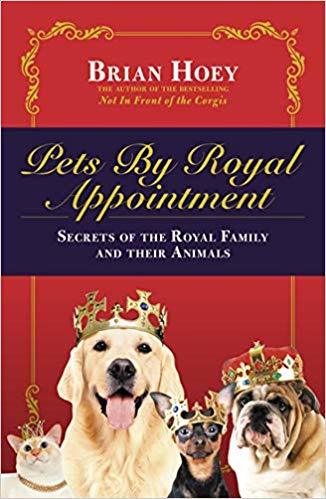
Pets by Royal Appointment: The Royal Family and Their Animals
Paperback – 8 August 2019 (UK) & 1 October 2019 (US)
The royal family say they can do without many things, but not their animals. For countless monarchs and their consorts, dogs, cats, horses and even the occasional parrot have acted as constant, faithful companions, unquestioning allies and surrogate children.
With intimate anecdotes and fascinating detail, royal expert Brian Hoey describes the mini palaces provided for the Queen’s pampered corgis; Princess Anne’s badly behaved bull terriers; the wild animals including crocodiles, hippopotami and an elephant presented to princes and princesses; a regal passion for all things equine; and the pigeon awarded a military medal for its efforts in the Second World War.
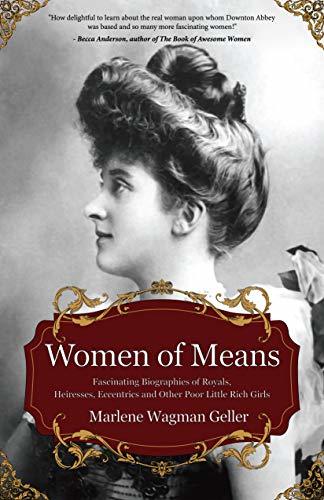
Women of Means: The Fascinating Biographies of Royals, Heiresses, Eccentrics and Other Poor Little Rich Girls
Paperback – 3 October 2019 (UK) & 15 August 2019 (US)
The Grass Isn’t Greener on the Other Side: Heiresses have always been viewed with eyes of envy. They were the ones for whom the cornucopia had been upended, showering them with unimaginable wealth and opportunity. However, through intimate historical biographies, Women of Means shows us that oftentimes the weaving sisters saved their most heart-wrenching tapestries for the destinies of wealthy women.
Happily Never After: From the author of Behind Every Great Man, we now have Women of Means, vignettes of the women who were slated from birth―or marriage―to great privilege, only to endure lives which were the stuff Russian tragic heroines are made of. They are the nonfictional Richard Corys―those not slated for happily ever after.
Women of Means is bound to be a non-fiction best seller, full of the best biographies of all time.
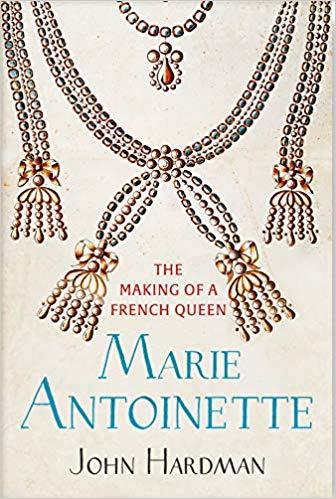
Marie-Antoinette: The Making of a French Queen
Hardcover – 24 September 2019 (UK) & 29 October 2019 (US)
Who was the real Marie-Antoinette? She was mistrusted and reviled in her own time, and today she is portrayed as a lightweight incapable of understanding the events that engulfed her. In this new account, John Hardman redresses the balance and sheds fresh light on Marie-Antoinette’s story.
Hardman shows how Marie-Antoinette played a significant but misunderstood role in the crisis of the monarchy. Drawing on new sources, he describes how, from the outset, Marie-Antoinette refused to prioritize the aggressive foreign policy of her mother, Maria-Theresa, bravely took over the helm from Louis XVI after the collapse of his morale, and, when revolution broke out, listened to the Third Estate and worked closely with repentant radicals to give the constitutional monarchy a fighting chance. For the first time, Hardman demonstrates exactly what influence Marie-Antoinette had and when and how she exerted it.
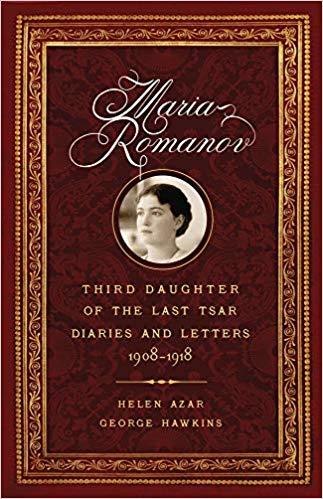
Maria Romanov: Third Daughter of the Last Tsar, Diaries and Letters, 1908–1918
Hardcover – 24 October 2019 (US) & 30 June 2019 (UK)
In the twilight of the nineteenth century, a third daughter was born to Tsar Nicholas II and his wife Alexandra. Grand Duchess Maria Nikolaevna—known to her family and friends simply as “Mashka”—grew into an empathetic, down-to-earth girl, unaffected by her imperial status. Often overshadowed by her two older sisters, Olga and Tatiana, and later, her brother Alexei and younger sister Anastasia, Maria ultimately proved to have a uniquely strong and solid personality.
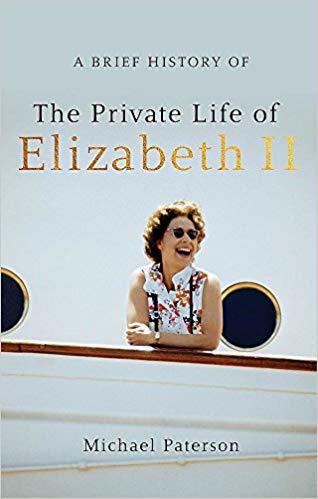
A Brief History of the Private Life of Elizabeth II (Brief Histories)
Paperback – 22 October 2019 (US)
Elizabeth II is the longest-reigning British monarch. A personally quiet, modest and dutiful person, she is far better-informed about the lives of her subjects than they often realize. She has known every Prime Minister since Winston Churchill and every American President since Eisenhower. Yet what of the woman behind the crown?

Queen Elizabeth II’s Guide to Life
Hardcover – 17 October 2019 (US & UK)
Queen Elizabeth II – Britain’s longest-serving monarch, Supreme Governor of the Church of England and the Head of the Commonwealth – has reigned over us for a record-breaking sixty-seven years. Now in her ninety-fourth year, this timely celebration sheds new light on the myriad attributes and personal qualities she brings to the nation.

A Lady in Waiting
Hardcover – 17 October 2019 (US & UK)
The remarkable life of Lady in Waiting to Princess Margaret who was also a Maid of Honour at the Queen’s Coronation – and is a character in The Crown this autumn. Anne Glenconner reveals the real events behind The Crown as well as her own life of drama, tragedy and courage, with the wonderful wit and extraordinary resilience which define her.
Anne Glenconner has been close to the Royal Family since childhood. Eldest child of the 5th Earl of Leicester, she was, as a daughter, described as ‘the greatest disappointment’ by her family as she was unable to inherit. Her childhood home Holkham Hall is one of the grandest estates in England. Bordering Sandringham the Princesses Elizabeth and Margaret were frequent playmates.
From Maid of Honour at the Queen’s Coronation to Lady in Waiting to Princess Margaret, Lady Glenconner is a unique witness to royal history, as well as an extraordinary survivor of a generation of aristocratic women trapped without inheritance and burdened with social expectations.
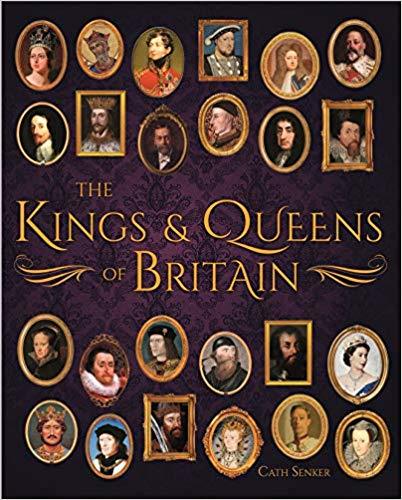
The Kings & Queens of Britain
Hardcover – 15 October 2019 (US & UK)
For more than 1,000 years the British monarchy has dramatically shaped national and international history. Kings and queens have conquered territory, imposed religious change and extracted taxation, each with their own motivations and ambitions.
In this beautifully illustrated book, Cath Senker delves into the extraordinary history of the British monarchy and its host of kings, queens and pretenders. There have been benevolent rulers, violent ones, religious fanatics, brilliant economists, masters of diplomacy and the power hungry. But whether they have abused their power or used it for good, each monarch has played a part in the rich tapestry of British history, coping with both international and civil wars, rebellions and criticism.
The Kings and Queens of Britain introduces this fascinating thousand-year history, providing rich biographical detail of Britain’s remarkable monarchs.

Our Rainbow Queen: A Tribute to Queen Elizabeth II and Her Colorful Wardrobe
Hardcover – 1 October 2019 (US & UK)
This riotously colorful book takes a photographic journey through Queen Elizabeth II’s ten decades of color-blocked style. The photographs, which span the colors of the rainbow and a century of style, are gloriously accessorized with captions and commentary by journalist and broadcaster Sali Hughes, who gives fascinating context to each photo. Readers will learn how the Queen has used color and fashion in strategic and discreetly political ways, such as wearing the colors of the European flag to a post-Brexit meeting or a pin given to her by the Obamas to a meeting with Donald Trump.
With stunning photographs that span from the 1950s to today, and featuring brilliant colors ranging from the dusky pinks the Queen wore in girlhood through to the neon green dress that prompted the hashtag #NeonAt90, this must-have collection celebrates the iconic fashion statements of the UK’s longest reigning and most vibrant monarch.

Daughters of Chivalry: The Forgotten Children of King Edward Longshanks
Hardcover – 1 October 2019 (US & UK)
Virginal, chaste, humble, patiently waiting for rescue by brave knights and handsome princes: this idealized―and largely mythical―notion of the medieval noblewoman still lingers. Yet the reality was very different, as Kelcey Wilson-Lee shows in this vibrant account of the five daughters of the great English king, Edward I, often known as Longshanks.
The lives of these sisters―Eleanora, Joanna, Margaret, Mary and Elizabeth―ran the full gamut of experiences open to royal women in the Middle Ages. Living as they did in a courtly culture founded on romantic longing and brilliant pageantry, they knew that a princess was to be chaste yet a mother to many children, preferably sons; meek, yet able to influence a recalcitrant husband or even command a host of men-at-arms. Edward’s daughters were of course expected to cement alliances and secure lands and territory by making great dynastic marriages, or endow religious houses with royal favor. But they also skillfully managed enormous households, navigated choppy diplomatic waters and promoted their family’s cause throughout Europe―and had the courage to defy their royal father. They might never wear the crown in their own right, but they were utterly confident of their crucial role in the spectacle of medieval kingship.

What Would Cleopatra Do?: Life Lessons from 50 of History’s Most Extraordinary Women
Paperback – 29 October 2019 (US & UK)
What Would Cleopatra Do? tackles issues by reminding us of inspiring feminists from the past, telling their stories with warmth, humor, and verve. From sticking up for yourself, improving body image, deciding whether to have children, finding a mentor, getting dumped, feeling like an imposter, being unattractive, and dealing with gossip, we can learn a lot by reading motivational stories of heroic women who, living in much tougher times through history, took control of their own destinies and made life work for them.
Here are Cleopatra’s thoughts on sibling rivalry, Mae West on positive body image, Frida Kahlo on finding your style, Catherine the Great on dealing with gossip, Agatha Christie on getting dumped, Hedy Lamarr on being underestimated—to list only a few—as well as others who address dilemmas including career-planning, female friendship, loneliness, financial management, and political engagement.
Featuring whimsical illustrations by L.A.-based artist Bijou Karman, What Would Cleopatra Do? is a distinctive, witty, and gift-worthy tribute to history’s outstanding women.
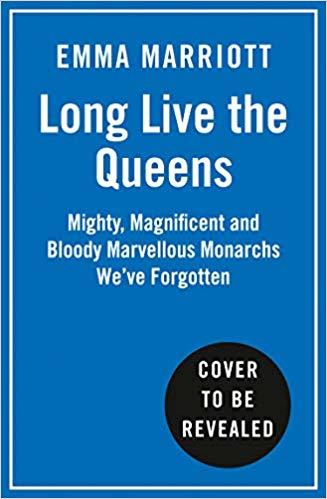
Long Live the Queens: Mighty, Magnificent and Bloody Marvellous Monarchs We’ve Forgotten
Hardcover – 17 October 2019 (US & UK)
Powerful and influential kings have long dominated our view of global history, their queens often relegated to the shadows, their influence, deeds and sacrifices unacknowledged and lost in the passing of time. But not anymore…
This book chronicles the forgotten queens from across the globe – those who ruled in their own right, and those who were wives or mothers of reigning kings. All of whom wielded significant power.
A smattering of queens, such as Queen Elizabeth I and Catherine the Great of Russia, are known and celebrated, but many more have been glossed over, maligned by historians or dismissed as mere bit-players on the world stage. We are all familiar with the great Roman emperors but what of Queen Zenobia, a rebel queen of the Middle East who took on the Roman Empire? William the Conqueror, the Norman invader of England in 1066, is an iconic figure in history, but how much do you know about his powerful ally and wife Matilda of Flanders?
Long Live the Queens rescues these phenomenal women from obscurity, exploring their achievements and deeds, and shedding light on the sacrifices female rulers throughout history have had to make in a patriarchal world.
Learn about the trailblazers, game-changers and mighty monarchs who have no business in being forgotten.
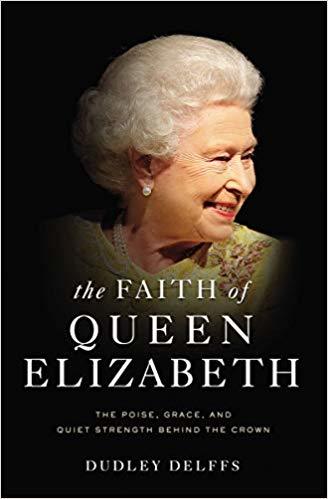
Faith of Queen Elizabeth
Hardcover – 31 October 2019 (UK) & 3 December 2019 (US)
Discover the inspiring spiritual legacy of Queen Elizabeth II, the longest reigning monarch in British history. Sharing a behind-the-scenes glimpse into the life of this notoriously private monarch, The Faith of Queen Elizabeth features intimate stories and inspiring reflections on the personal faith behind the Crown. With testimonies from historic figures such as Winston Churchill, Billy Graham, Mother Teresa, and Margaret Thatcher, this magnificent tribute explores the faith of the world’s most famous Queen – and the King she serves. Icon, matriarch, reformer, and the longest-reigning monarch in British history – Queen Elizabeth II intrigues millions around the world with her royal heritage, inspirational character, and profound faith, especially as depicted in award-winning films such as The Queen and the wildly popular Netflix series The Crown. With a reign that bridges the twentieth and twenty-first centuries, Queen Elizabeth has become the definition of stability, faithfulness, and dignity. Fearlessly, she led her country into the modern age with a balance of historical tradition and entrepreneurial initiative, public service and private devotion. Nearing seven decades on the throne, the Queen has faced many personal and public storms – an early and surprising ascension to the throne, the dissolution of the British Empire, political upheavals, international crises, national tragedies, family deaths, and the tabloid travails of her children and grandchildren. But throughout all her trials and triumphs, Her Majesty credits her personal faith in Jesus Christ as the steadying anchor to her life and reign. In this spiritual biography, Dudley Delffs unpacks the secret behind Her Majesty’s personal devotion and public service, giving you a fuller, richer picture of the woman who’s led a nation with unwavering faith and resolve.
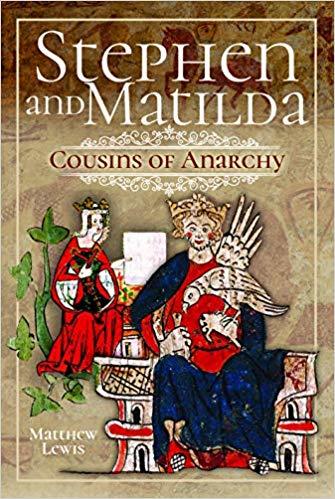
Stephen and Matilda’s Civil War: Cousins of Anarchy
Hardcover – 30 October 2019 (UK) & 2 February 2002 (US)
The Anarchy was the first civil war in post-Conquest England, enduring throughout the reign of King Stephen between 1135 and 1154. It ultimately brought about the end of the Norman dynasty and the birth of the mighty Plantagenet kings. When Henry I died having lost his only legitimate son in a shipwreck, he had caused all of his barons to swear to recognize his daughter Matilda, widow of the Holy Roman Emperor, as his heir and remarried her to Geoffrey, Count of Anjou. When she was slow to move to England on her father’s death, Henry’s favourite nephew Stephen of Blois rushed to have himself crowned, much as Henry himself had done on the death of his brother William Rufus. Supported by his brother Henry, Bishop of Winchester, Stephen made a promising start, but Matilda would not give up her birthright and tried to hold the English barons to their oaths. The result was more than a decade of civil war that saw England split apart. Empress Matilda is often remembered as aloof and high-handed, Stephen as ineffective and indecisive. By following both sides of the dispute and seeking to understand their actions and motivations, Matthew Lewis aims to reach a more rounded understanding of this crucial period of English history and asks to what extent there really was anarchy.
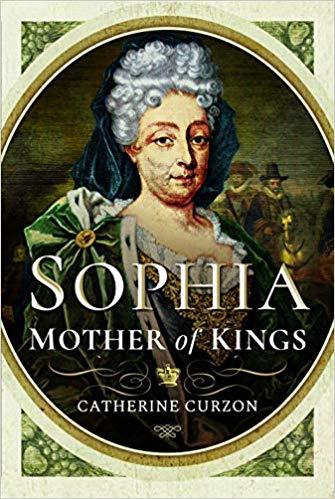
Sophia: Mother of Kings
Hardcover – 30 October 2019 (UK) & 2 February 2020 (US)
Sophia, Electress of Hanover, was born to greatness. Granddaughter of James I and mother to George I, she was perhaps the finest queen that Britain never had. As daughter of Frederick V of the Palatinate and Elizabeth Stuart, Sophia emerged from an impoverished, exiled childhood as the Winter Princess, a young woman of sparky intelligence, cutting wit and admirable determination. Once courted by Charles II, Sophia eventually gave her heart to Ernest Augustus, at whose side she became the first Electress of Hanover and the mother of the first Georgian king of Great Britain. Sophia: Mother of Kings, brings this remarkable woman and her tumultuous era vividly to life. In a world where battles raged across the continent and courtiers fought behind closed doors, Sophia kept the home fires burning. Through personal tragedy and public triumph, Sophia raised a family, survived illness, miscarriage, and accusations of conspiracy, and missed out on the British throne by a matter of weeks. Sophia of Hanover became the mother of one of the most glittering dynasties the world has ever known. From the House of Stuart to the House of Hanover, this is the story of her remarkable life.

Unearthing the Family of Alexander the Great: The Remarkable Discovery of the Royal Tombs of Macedon
Hardcover – 30 October 2019 (UK) & 2 February 2020 (US)
In October 336 BC, statues of the twelve Olympian Gods were paraded through the ancient capital of Macedon. Following them was a thirteenth, a statue of King Philip II who was deifying himself in front of the Greek world. Moments later Philip was stabbed to death; it was a world-shaking event that heralded in the reign of his son, Alexander the Great. Equally driven by a heroic lineage stretching back to gods and heroes, Alexander conquered the Persian Empire in eleven years but died mysteriously in Babylon. Some 2,300 years later, a cluster of subterranean tombs were unearthed in northern Greece containing the remains of the Macedonian royal line. This is the remarkable story of the quest to identify the family of Alexander the Great and the dynasty that changed the Graeco-Persian world forever. Written in close cooperation with the investigating archaeologists, anthropologists, and scientists, this book presents the revelations, mysteries and controversies in a charming, accessible style. Is this really the tomb of Philip II, Alexander’s father? And who was the warrior woman buried with weapons and armour beside him?
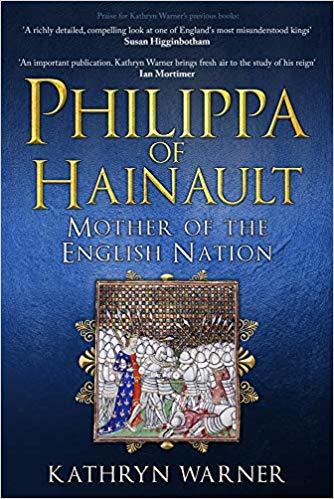
Philippa of Hainault: Mother of the English Nation
Hardcover – 15 October 2019 (UK) & 1 February 2020 (US)
Philippa of Hainault: Mother of the English Nation is the first full-length biography of the queen who stood in the middle of the some of the most dramatic events in English history.
Philippa’s marriage was arranged in order to provide ships and mercenaries for her mother-in-law to invade her father-in-law’s kingdom in 1326, yet it became one of the most successful royal marriages in English history and endured for more than four decades. The chronicler Jean Froissart described her as ‘The most gentle Queen, most liberal, and most courteous that ever was Queen in her days.’
Philippa stood by her husband’s side as he began a war against her uncle, Philip VI of France, and claimed his throne. She frequently accompanied him to Scotland, France and Flanders. She also acted as regent in 1346 when Edward was away from his kingdom at the time of a Scottish invasion, and appeared on horseback to rally the English army to victory.
Philippa became popular with the people due to her kindness and compassion, demonstrated when she sought pity for the Burghers of Calais and persuaded King Edward to spare their lives. This popularity helped maintain peace in England throughout Edward’s reign. Her son, later known as the Black Prince, became one of the greatest warriors of the Middle Ages.
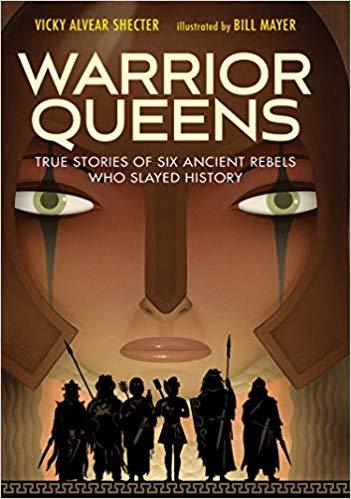
Warrior Queens: True Stories of Six Ancient Rebels Who Slayed History
Hardcover – 7 October 2019 (UK) & 10 September 2019 (US)
The true life stories of six little-known fierce ancient warrior queens are told with humor and vivid detail by an award-winning writer. For young readers seeking to be inspired by stories of strong women, this riveting book shines a light on six powerful ancient queens. Highlighting women warriors who ruled in ancient eras, like Hatshepsut in 1492 BCE Egypt, and Zenobia in 260 CE Palmyra, the stories span the globe to reveal the hidden histories of queens who challenged men and fought for the right to rule their queendoms. Award-winning author Vicky Alvear Shectar’s lively text and acclaimed illustrator Bill Mayer’s witty illustrations showcase these stories filled with history, power, and humor.
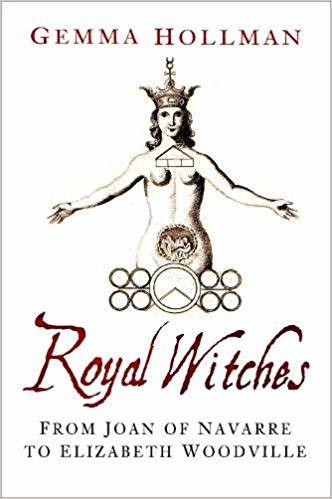
Royal Witches: From Joan of Navarre to Elizabeth Woodville
Paperback – 1 October 2019 (UK & US)
Until the mass hysteria of the seventeenth century, accusations of witchcraft in England were rare. However, four royal women, related in family and in court ties – Joan of Navarre, Eleanor Cobham, Jacquetta of Luxembourg and Elizabeth Woodville – were accused of practising witchcraft in order to kill or influence the king.
Some of these women may have turned to the dark arts, but the purpose of the accusations was purely political. Despite their status, these women were vulnerable because of their gender as the men around them moved them like pawns for political gains.
In Royal Witches, Gemma Hollman explores the lives and the cases of these so-called witches. In a time when the line between science and magic was blurred, these trials offer a tantalising insight of how malicious magic would be used and cause such mass hysteria in centuries to come.
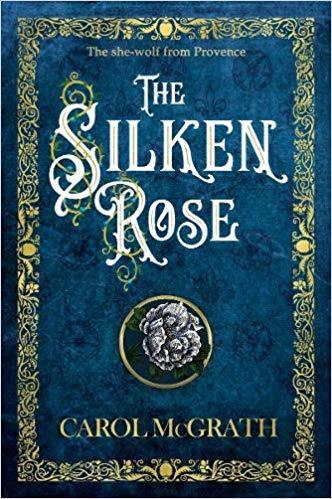
The Silken Rose
Paperback – 19 September 2019 (US) & 3 October 2019 (UK)
1236. Beautiful Ailenor of Provence, cultured and intelligent, is only thirteen when she marries Henry III. Aware of the desperate importance of providing heirs to secure the throne from those who would snatch it away, she is ruthless in her dealings with Henry’s barons.
As conflict escalates between them, Ailenor’s shrewd and clever Savoyard uncles come to support her but her growing political power is threatened when Henry’s half-siblings also arrive at court.
Henry and Ailenor become embroiled in an unpopular war to protect Gascony, last English territory on the continent, sparking conflict with warrior knight, Simon de Montfort, the King’s seneschal.
Ailenor, desperate to protect Gascony for her son, strives to treat with France and bring peace to Gascony.
Caught in a web of treachery and deceit, ‘she-wolf’ Ailenor’s courage is tested to the limit. Can she find the strength to control her destiny and protect her all that she holds dear?

The Prince & I: My Life with Prince Bira of Siam
Paperback – 12 November 2019 (US) & 7 October 2019 (UK)
The Prince & I is the the story of the passionate love of Bira, Prince of Siam, grandson of King Mongkut of The King & I fame, and the young Englishwoman who would become his wife, Princess Ceril Birabongse. The fascinating autobiography charts the life of Prince and Princess Birabongse, a life that was constantly filled with excitement and fascinating people, including Noel Coward, Princess Marina, The Duchess of Kent, and even Anthony Blunt and Guy Burgess. Illustrating her narrative with a selection of private photographs, extending from her childhood years to her elegant retirement on Lake Garda, the author paints a rich picture of life during the golden days of the 1930s, and of a man who was not only a Prince, but a sculptor, Olympic sailor, and racing driver – the only Southeast Asian Formula One driver of the 20th Century.
The post Book News October 2019 appeared first on History of Royal Women.
September 19, 2019
Beatrice of Flanders – The substitute bride
Beatrice of Flanders was born in Bruges circa 1253/1254 as the daughter of Guy of Dampierre, Count of Flanders and his first wife Matilda of Béthune. She had seven full siblings and eight half-siblings – from her father’s second marriage to Isabelle of Luxembourg.
Beatrice married the 14-year-old Floris V, Count of Holland in 1269. Their marriage was part of a peace treaty between Holland and Flanders. The treaty initially demanded that Guy of Dampierre’s eldest daughter should marry Floris’ uncle and guardian, known as Floris de Voogd, but if he should die before his nephew, Floris himself would take his place as the groom. This came into force when Floris de Voogd unexpectedly died on 26 March 1258. Floris did end up marrying one of Guy’s daughters, just not the eldest, Margaret, but Beatrice. It is unclear why as Margaret was still unmarried, but she did end up marrying John I, Duke of Brabant in 1273.
Beatrice and Floris went on to have at least seven children together, though possibly as many as nine. One source states that six sons and one daughter are buried together under a single stone in Loosduinen. Only two of their children survived infancy, so if that source is correct, they had nine children. Their two surviving children were Margaret who was born circa 1280 and John who was born circa 1284. Margaret was engaged in 1281 to Alphonso, Earl of Chester, son and heir apparent of King Edward I of England, until Alfonso’s death in 1284. Margaret died sometime in the summer of 1295. John too made an English match, and he was married to Elizabeth of Rhuddlan, a daughter of King Edward I.
During the siege of Middelburg in 1290, Beatrice brought her six-year-old son to the city to boost morale, and the city managed to hold strong for several months.
Floris took his son to England in early 1291 to make his claim for the Scottish throne (through his descent from Ada of Huntingdon). He took his son John with him as his wedding treaty of 1285 determined he should be raised in England. In his absence, Beatrice acted as head of a regency council. His claim for the Scottish throne was unsuccessful.
Beatrice died just before her husband. She was probably ill for quite a while before her death on 23 March 1296. Her husband was brutally murdered in a conspiracy on 27 June 1296. They were both buried in Rijnsburg Abbey.1
The post Beatrice of Flanders – The substitute bride appeared first on History of Royal Women.
September 18, 2019
The Year of Queen Victoria – Victoria and Albert’s grandchildren
Queen Victoria married her first cousin Prince Albert of Saxe-Coburg and Gotha. Together they went on to have nine children and 42 grandchildren. Only Princess Louise did not have children of her own. Their grandchildren included an Emperor, an Empress, a King, four Queens and a Crown Princess. Her son Leopold suffered from haemophilia and two of her daughters – Alice and Beatrice – passed the gene to their children. Leopold’s daughter was a carrier of the gene while his son was healthy. Princess Alice married the future Louis IV, Grand Duke of Hesse in 1862 and they went on to have seven children together. Of Alice’s two sons, one suffered from haemophilia and the two-year-old Friedrich died after a fall. Of her five daughters, two were definitely carriers- Alix, the future Tsarina of Russia and Irene, who married Prince Henry of Prussia – of the gene as they passed it on to their children. Princess Beatrice married Prince Henry of Battenberg in 1885. Of their three sons, one was a haemophiliac, while their only daughter Victoria Eugenie was a carrier of the gene.
So, who were all these grandchildren?
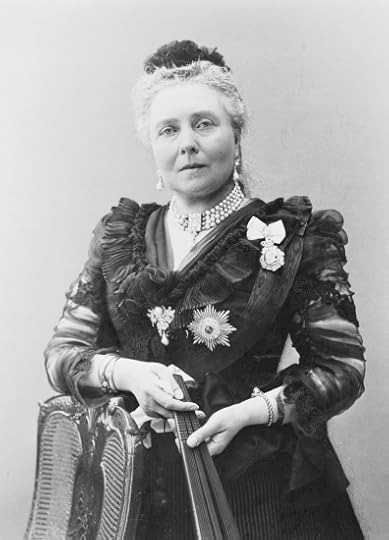 Royal Collection (Public Domain)
Royal Collection (Public Domain)Victoria, Princess Royal
1. Wilhelm II, German Emperor and King of Prussia
2. Princess Charlotte, later Duchess of Saxe-Meiningen
3. Prince Henry of Prussia
4. Prince Sigismund of Prussia
5. Princess Viktoria, later Princess Adolf of Schaumburg-Lippe
6. Prince Waldemar of Prussia
7. Princess Sophie, later Queen of the Hellenes
8. Princess Margaret, later Landgravine of Hesse-Kassel
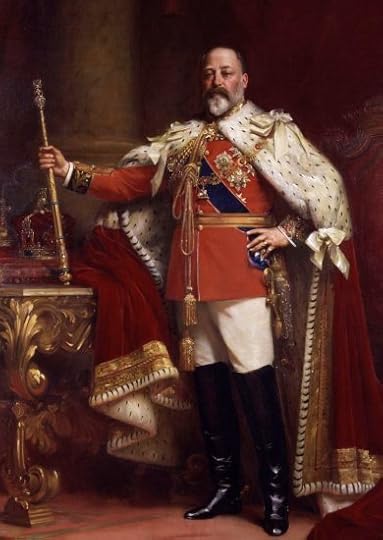 (public domain)
(public domain)King Edward VII
1. Prince Albert Victor, Duke of Clarence
2. King George V
3. Louise, Princess Royal, later Duchess of Fife
4. Princess Victoria
5. Princess Maud, later Queen of Norway
6. Prince Alexander John of Wales
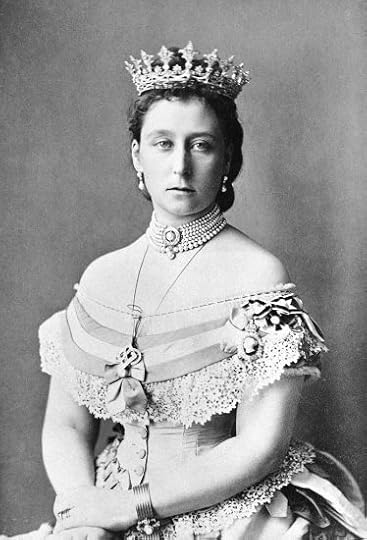 (public domain)
(public domain)Princess Alice
1. Princess Victoria, later Marchioness of Milford Haven
2. Princess Elisabeth, later Grand Duchess Elizabeth Feodorovna of Russia
3. Princess Irene
4. Ernest Louis, Grand Duke of Hesse
5. Prince Friedrich
6. Princess Alix, later Empress of Russia
7. Princess Marie
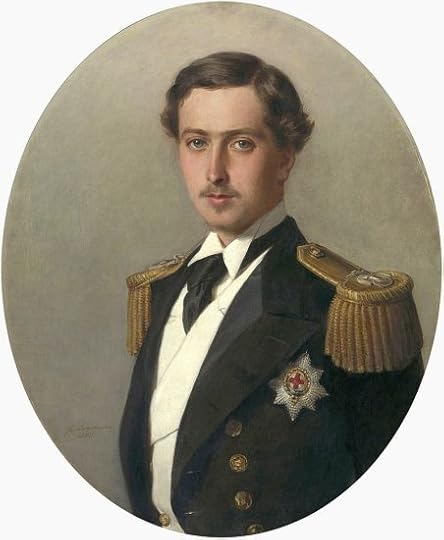 (public domain)
(public domain)Alfred, Duke of Saxe-Coburg and Gotha
1. Alfred, Hereditary Prince of Saxe-Coburg and Gotha
2. Princess Marie, later Queen of Romania
3. Princess Victoria Melita, later Grand Duchess Victoria Feodorovna of Russia
4. Princess Alexandra, later Princess of Hohenlohe-Langenburg
5. Stillborn son
6. Princess Beatrice, later Duchess of Galliera
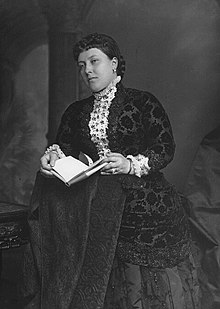 (public domain)
(public domain)Princess Helena
1. Prince Christian Victor
2. Prince Albert
3. Princess Helena Victoria
4. Princess Marie Louise, later Princess Aribert of Anhalt
5. Prince Harald
6. Stillborn son
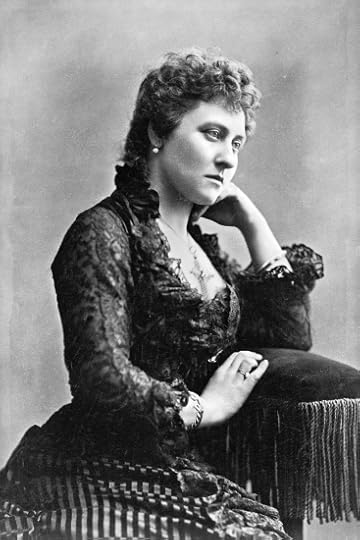 Royal Collection (Public Domain)
Royal Collection (Public Domain)Princess Louise
No issue.
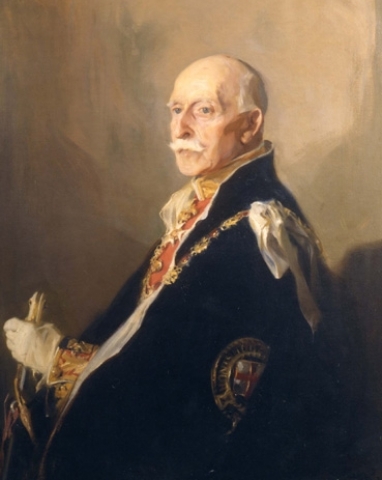 (public domain)
(public domain)Arthur, Duke of Connaught and Strathearn
1. Princess Margaret, later Crown Princess of Sweden
2. Prince Arthur of Connaught
3. Princess Patricia of Connaught, later Lady Patricia Ramsay
 (public domain)
(public domain)Leopold, Duke of Albany
1. Princess Alice, later Countess of Athlone
2. Charles Edward, Duke of Saxe-Coburg and Gotha
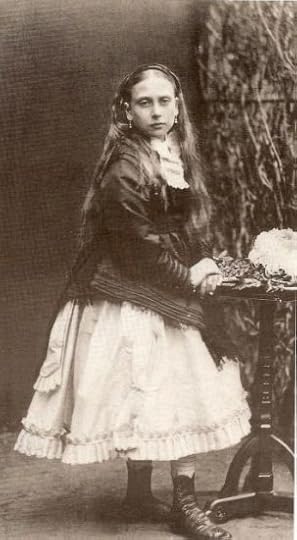 (public domain)
(public domain)Princess Beatrice
1. Prince Alexander, later 1st Marquess of Carisbrooke
2. Princess Victoria Eugénie, later Queen of Spain
3. Prince Leopold, later Lord Leopold Mountbatten
4. Prince Maurice
The post The Year of Queen Victoria – Victoria and Albert’s grandchildren appeared first on History of Royal Women.



